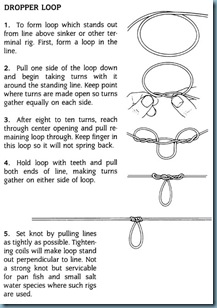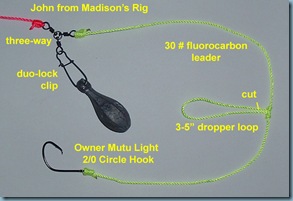The
amount of books, websites, videos, et cetera concerning knots for
various professions (sailors, scouts, climbers, cavers, rescue
professionals, fisherman and surgeon) is prolific. Start with the basic
knots when learning and work your way to the harder ones. As more knots
are learned, the knot tying patterns become more evident in the methods
of their tying and you will also learn what knot works best for whatever
application you choose to use it for. Of course, as anyone can tell you
it takes patience and practice to learn (and repetition) and will help
you retain the memory of how to tie knots and what they are used for. In
every day life, knot tying is an important thing to know, at least the
basic ones. The first time we have learned to tie a knot in our lives
was when we had to tie our own shoes as a child.
This
particular series of pages focuses upon knots used by anglers –
fisherman – whether professional, sportsman or those who are trying out
the sport of fishing for the first time. Obviously, strong knots are
important to prevent from losing that big one you may catch, as well as
knowing the properties of line you are using and what lines to use for
whatever fishing situation.
Some important information about knots [Wikipedia]:
- Knots will eventually weaken rope and usually fails in or near the knot itself unless it is damaged in another portion. The relative knot strength is called knot efficiency. It means the breaking strength of a knotted rope as to the proportion of the breaking strength of the rope without the knot. The type of fiber, the style of the rope, the size of the rope/line, how the knot is dressed before loading, how rapidly the knot is loaded, whether the knot is repeatedly loaded, et cetera. Most common knots have efficiency of 40% to 80%.
- Rope splices can retain nearly the full strength of the rope when forming loops and bends, but conventional knots are more practical. As with rope, fisherman must inspect, check and replace their line often – except for the Berkley® Fireline or a couple of the Spider® line series. Personally, I have found the Fireline to be more reliable than the Spider® brand. It is not cheap, however, costing about $14 per 100 yards.
While
fishing knots are not dependent upon for life-threatening or dangerous
situations, when tying knots for anything, always ensure that the knot
is made to do what it is supposed to do and tied correctly. This
probably applies more to boating knots, emergency procedures, climbing
knots, et cetera.
_______________Albright Knot
Albright Knot – This knot is used to join monofilament line with different diameters. An example would be to tie monofilament to braided fishing line. Braided fishing line is expensive and because the last quarter of the reel is usually not used, one can save money by using the Albright knot to connect the first quarter of the line on a reel with the rest being braided. You will have the strength of braided line but save money on the amount of line at the end of the reel by using monofilament. The drawing shows the knot completed. For best view of how to tie this knot, visit Animated Knots by Grog – the Albright Knot. This knot is used by fly fisherman and it will pass through rod guides easily. To make it more smooth and secure, coat it with liquid tape, a product designed for use on electrical connections in lieu of black electrical tape.
_____________________
Arbor Knot
Arbor Knot - The arbor knot is an easy tie method for securing the end of the line to the arbor of the fishing reel. Some of the new baitcasting reels have holes drilled into reel spool to make line spooling easier, but most reels so far have no holes, so the arbor knot comes in handy. This knot and others can be found in the book of Practical Fishing Knots by Mark Sosin and Lefty Kreh. The following drawing describes the knot:
 This knot can be viewed in an animated presentation at Grog's Fishing Knot Website.
This knot can be viewed in an animated presentation at Grog's Fishing Knot Website._____________
Dropper Loop Knot
The Dropper Loop knot is a way to create a loop in the middle of your leader or line tippet and by rigging an additional hook or fly when making something like a worm harness (which is used frequently here at Door Peninsula). The advantage of this knot is that the line helps avoid tangles when casting.
The following diagram will help you learn to tie this knot as well as viewing Animated Knots by Grog.

Drawing of an application of dropper loops in something that some call the "trout line". Make sure that your local fishing regulations have not outlawed this type of fishing tackle.
And last, a special dropper loop rig -

_________________
Palomar Knot
The Palomar Knot is recommended for tying hooks, swivels and lures to Berkley® Fireline, but it can be used with any line – braided, monofilament, and fusion. This knot is my favorite and I used it regularly now. It doesn’t look as pretty as the basic Fisherman’s Knot, but it does the job. The nice thing about this knot is that you can tie it in the dark once you know how to tie it. The downside of this knot is that you must pass the lure, fly or hook through the loop which can be awkward; however with practice, this hasn’t been a problem for me. Just watch out that you don’t hook yourself when first using this knot.
There is also the Triple Palomar Knot, which makes the regular Palomar Knot even stronger. To tie the Triple Palomar:
1 – Double the line and pass it through the eye of the hook so a loop is formed.
2 – Repeat this step twice for the Triple Palomar or go on to the next step for the regular Palomar Knot. In the Triple Palomar you will end up with two extra loops of doubled line formed on the eye of the hook.
3 – Close the three loops (or one loop) around the eye of the hook, and then wrap the protruding loop of doubled line back through the main line and tag.
4 – Pass it back through the loop so an overhand knot is formed.
5 – Loop the doubled line over the hook, lure, leader, or swivel.
Your done. Below is an illustration of how to tie the single Palomar Knot. And you can view an animated demonstration at Grog’s Animated Fishing Knots.
________________
Snell Knot
The Snell Knot is probably one of the older knots and is well-known because of the various snelled hooks available at fishing tackle stores and departments. It is a knot that is supposed to be reliable and preserve the strength of the line – especially if the thickness of the eye is greater than the line of the diameter.
You can view on how to tie this knot at Grog’s Animated Knots.

_______________________
Fishing Knot Terms
The following are terms used when discussing knots ...
Butt – The thick part of the leader. The butt of a leader is attached to the fishing line.
Tag or Tag End – The working end, the part of the line where the knot is tied.
Standing Part – The main part of the line that is fixed and under tension. Such as the part of line that is on the reel.
Standing End – The short part of line at the end of the standing part.
Working End – The part of the lines that is used in tying a knot. The opposite of the standing end.
End – A loop that is a closed curved line, formed by bringing the tag end back and along the standing part, or a knot that creates a loop.
Tippet – The end of a leader to which the lure is attached. The tippet can be the end of a leader or an added line to the end of a leader.
Turns or Wraps – A turn or wrap is one complete revolution of line around another.
Overhand Knot – The foundation for many other knots, it is a Granny Knot before it is pulled tight.
_____________